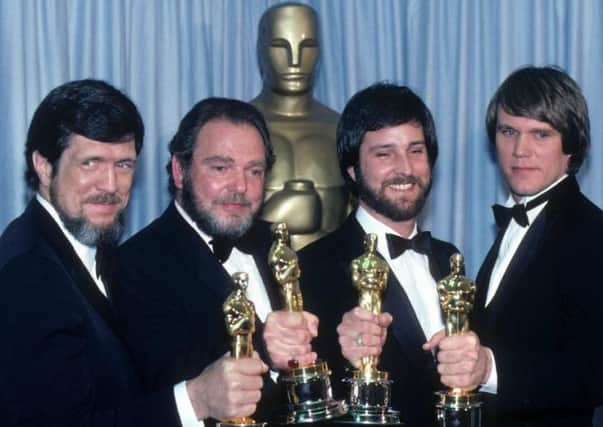Obituary: Kit West, film special effects supervisor


Kit West went from shooting other technicians’ special effects in feature films to creating them himself. His expertise in “old school” mechanical effects was recognised with prestigious awards for his work on two of the world’s most lucrative film franchises.
Particularly memorable in Raiders of the Lost Ark (1981), starring Harrison Ford as Indiana Jones in the comic-book-style adventure brought to the screen by director Steven Spielberg and producer George Lucas, were the “rolling boulder” opening sequence and “face-melting” scene he brought to life. His skills won him an Oscar for Best Visual Effects, shared with Richard Edlund, Bruce Nicholson and Joe Johnston, other key members of the film crew.
Advertisement
Hide AdAdvertisement
Hide AdA Bafta Award for Special Visual Effects followed when West was part of the team responsible for the dazzling images in the third Star Wars film, Return of the Jedi (1983, now titled Star Wars: Episode VI – Return of the Jedi), at times battling with the intense heat of Arizona’s Yuma Desert and rain in the redwood forests of northern California.
His task included overseeing the speeder bikes, hover skiff and robots, including the radio-controlled R2-D2, created by Tony Dyson.
Christopher John West was born in Wandsworth, London, the son of Clifford and Dorothy (née Collins), and brought up in East Sheen. On leaving King’s House School, Richmond, he became a trainee camera assistant with Realist Film Unit, one of the leading independent producers of documentaries.
After national service in the Army in Malaysia and Singapore – where he learned about pyrotechnics and detecting explosive devices – he returned to the company, which had branched out into making television commercials with its offshoot Impact Telefilms. From camera assistant, he rose to director of photography.
West then worked for several other companies producing commercials before joining Anglo-Scottish Pictures as a camera operator in its photographic effects department. In the same studio was Canadian special effects expert Les Bowie, who decided to move his Bowie Films business to an old warehouse in Slough previously occupied by TV puppet producer Gerry Anderson.
West joined him as an in-house camera operator and began to create photographic effects for feature films.
Making the transition to shooting physical effects, West worked with Bowie on a string of Hammer Films productions – Paranoic (1963), The Damned (1963), directed by Joseph Losey, The Kiss of the Vampire (1963), She (1965) and Quatermass and the Pit (1967) – as well as First Men in the Moon (1964), based on the HG Wells story.
With Bowie, he was also responsible for shooting the model planes in Mosquito Squadron (1969) , the Lunar Module and moonscape in the Hammer sci-fi Western Moon Zero Two (1969) and the explosion of an enormous castle miniature in The Adventures of Gerard (1970).
Advertisement
Hide AdAdvertisement
Hide AdWhile still working as a cinematographer for Bowie Films, West became a fully fledged special effects supervisor in his own right, with his own team.
He was responsible for war-scene explosions in the Second World War drama The Battle of the Bulge (1965), starring Henry Fonda and shot in the Segovia highlands outside Madrid, then headed to the Spanish coastal city of Almeria to supervise special effects on Lost Command (1966), starring Anthony Quinn as a French officer in Indochina and Algeria.
Almeria became a second home to West while working on a dozen films there. They included another war drama, Play Dirty (1969), starring Michael Caine, and the Spaghetti Westerns El Condor (1970), “Doc” (1971), Catlow (1971) and Charley-One-Eye (1973).
He was in Hungary for Woody Allen’s Love and Death (1975), France and Germany for The Pink Panther Strikes Again (1976) – which features the destruction of both Clouseau’s apartment and the United Nations building, as well as explosions caused as star Peter Sellers fumbles through James Bond-style technological weaponry – Canada for director Sidney Lumet’s Equus (1977), South Africa for The Wild Geese (1978) and Germany and India for The Sea Wolves (1980).
Back in Britain, West recreated the detective’s drug-induced nightmares in Young Sherlock Holmes (1985) – gaining him a second Oscar nomination – before returning to Spain and being reunited with Steven Spielberg for Empire of the Sun (1987), which includes explosions created by Mustangs dive-bombing an airfield.
West had a further Oscar nomination for his physical, pyrotechnic and atmospheric effects in DragonHeart (1996), as well as the giant dragon’s mouthpiece in which star Dennis Quaid was secured with a harness, and there were explosions on land for Daylight (1996) and at sea for Enemy at the Gates (2001).
He also worked on The Bourne Supremacy (2004) and finished his career with City of Ember (2008).
In later years, West saw the introduction of computer-generated imagery to modern-day Hollywood blockbusters.
Advertisement
Hide AdAdvertisement
Hide Ad“I would not say that the CGI industry is replacing the standard practical live-action effects,” he said in a 2010 interview. “If anything, they are enhancing a lot of what I create.”
He is survived by his wife, Diana (née Jefferson), whom he married in 1970, daughter Rebecca, who worked for some years as a film publicity assistant, and granddaughter Indiana, named after the screen hero in the film for which West won an Oscar.